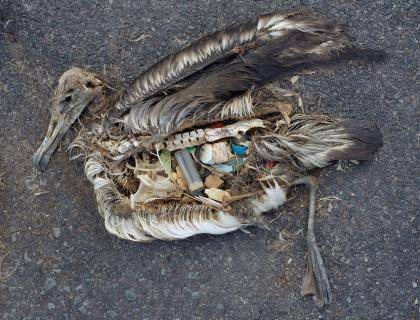When Grief is Good
Photographer Chris Jordan uses art to confront environmental distress

Chris Jordan does not mind grief.
Discussing his film "Midway" Wednesday at Duke, the photographer and activist said witnessing the lives and deaths of thousands of albatrosses on a remote Pacific island taught him that grief was "not necessarily a bad thing."
"It's a natural response to what's being lost," Jordan said. "And it's no different from love. I discovered that when I stepped into grief, I didn't slip into the abyss. I felt more love than I ever had before, for these baby birds, for our miraculous world."
Jordan is spending a week at Duke as part of the Dance Program conference "Across the Threshold" which runs through Saturday.
Jordan spent several weeks in 2009 photographing baby albatrosses that had died from eating the plastic garbage washed up on the island. According to Jordan, the fast-moving Pacific Ocean delivers five tons of plastic garbage to Midway every year. As Jordan witnessed hundreds of young birds die from plastic consumption, he said he recognized the love that accompanies sadness.
"The Dalai Lama isn't the only person with deep wisdom and compassion," Jordan said. "We all have it in us, but it gets buried under all the rushing around. We have to let grief show us our deep abiding love for the world."
Duke's Screen/Society program co-sponsored Jordan's talk. Screen/Society director Hank Okazaki said such images distinguish Jordan from other activists.
"He is especially gifted at presenting complex large-scale global phenomena and scientific data, through his art and his public speaking, in a way that makes it hit home to the viewer or listener in a more direct and personal way," Okazaki said.
Jordan's talk had that affect on Art, Art History, and Visual Studies professor Raquel Salvatella de Prada. The talk convinced her to join Jordan's movement of using art to highlight the reality of environmental destruction.
"I was so afraid I would go crazy from grief while working on a project like this," de Prada said. "But now I do not believe grief is bad. You just have to confront it like Chris and show these [environmental] problems in a visual way, in a beautiful way."
For more information on Jordan's work, visit chrisjordan.com. For more upcoming Screen/Society events, visit http://ami.duke.edu/events/archive/tags/ScreenSociety/2013/spring.